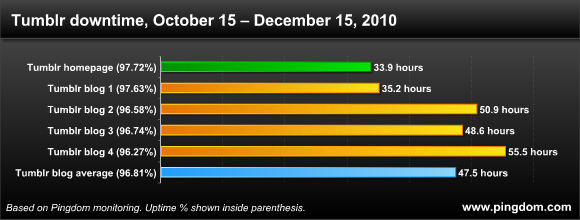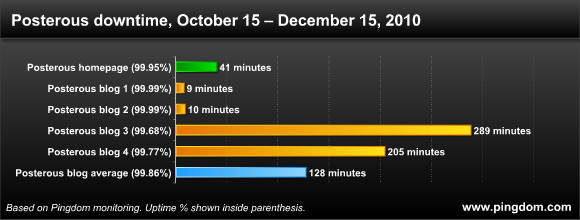
Blogging services have been around for a long time, with pioneers like Blogger paving the way for WordPress.com and more recent arrivals like Tumblr and Posterous. There are millions upon millions of blogs out there, many of them residing on these services.
One big bonus of using a blogging service is that they take much of the pain away from having a blog since they handle the hosting for its users and everything is already set up. Once you publish, the responsibility for keeping that content available online rests firmly on the shoulders of the blogging service.
With that in mind, we decided to test five of today’s most popular blogging services to see how reliable they actually are.
Which services we tested, and how
We included Blogger, WordPress.com, Typepad, Tumblr and Posterous in this survey. There are of course other services out there as well, but we chose to focus on these since it’s quite likely that if you’re currently on a blogging service, you’re on one of these five.
For each blogging service, we monitored the uptime of the homepage and four individual blogs, so we could see how the service as a whole performed. For the details, check out our “Methodology” section at the bottom of this post.
The tests were performed once a minute over a period of two months, October 15 – December 15. We used the Pingdom website availability monitoring service (of course), performing tests from multiple locations in North America and Europe.
Key findings
- The reliability winner(s). The winner was without a doubt Google’s Blogger. The Blogger blogs didn’t have any downtime whatsoever during the two months we monitored them, followed by WordPress.com which had very little downtime. Typepad deserves an honorable mention here as well. Posterous had somewhat mixed results, but overall receives a passing grade. Tumblr was the only service in the test that truly failed.
- Tumblr’s troubles. Tumblr has had a rough time with their stability lately, which is made abundantly clear by this survey. Most of the monitored blogs had very little downtime, but the Tumblr blogs all had a huge amount of downtime for such a short period of time. Some Tumblr blogs were down for a total of more than two days during the two-month period of this survey. Tumblr also had the single longest outage by far, where its blogs were unavailable for almost 24 hours on December 5-6.
- Not all blogs are created equal, even within the same blogging service. Downtime can vary significantly between blogs on the same service, presumably depending on which servers the blogs are hosted on. It’s a similar situation to that of shared hosting, where you can end up on servers that perform worse than others for various reasons.
Blogging service downtime
The bars in the chart below represent the average downtime per blog over these two months, based on the four blogs we tested for each service.

To dive deeper, please check out the individual sections below where we expand on the numbers for each blogging service.
Tumblr overview
- Tumblr homepage uptime: 97.72%
- Average Tumblr blog uptime: 96.81%
We’ll be writing a bit more about Tumblr than about the other services for the simple reason that more of note happened. The rather extreme results are worth a closer look.

The single longest outage was identical on all four blogs, a full 23 hours and 44 minutes of downtime that started late on the 5th of December. The Tumblr homepage was also affected, but was “only” down for 22 hours and 16 minutes. This huge outage was according to Tumblr caused by a database cluster failing during maintenance.
However, it should be noted that Tumblr’s problems haven’t just been a few big outages, but a large number of smaller ones. The Tumblr blogs we monitored had an average of more than 300 outages during these two months, some very brief, indicating an ongoing performance issue with the service.
We feel for Tumblr, because it’s quite likely that they’ve had issues scaling the service in face of its growing popularity. Tumblr currently has more than 11 million blogs, and they’ve stated that traffic to the service is increasing with more than 500 million page views each month.
This rapid growth is bound to be a factor in the downtime we’ve seen. The important thing now is how Tumblr will handle this going forward. They are no doubt working hard on increasing the capacity of their infrastructure.
Posterous overview
- Posterous homepage uptime: 99.95%
- Average Posterous blog uptime: 99.86%
The results for Posterous were a bit mixed, as you’ll see below, and we’ll explain what we could see.

No single outage exceeded 20 minutes.
We noticed something with Posterous that we didn’t see with any of the other blogging services, and that is that for some reason the external, custom domain names that pointed to Posterous blogs were slower and occasionally timed out, which effectively resulted in more downtime. (Blogs 3 and 4 on each service use custom domain names instead of subdomains, i.e. www.example.com instead of example.posterous.com. See why under “Methodology at the bottom of this post.).
First we thought that maybe these custom domain names had DNS issues, in which case we would have removed any bad results caused by that since it wouldn’t have been fair to Posterous. However, the DNS resolution itself wasn’t slow, and what seemed to be causing the slowness was as far as we could see a series of redirects after getting to Posterous. It could be a coincidence, but Posterous might want to look into this just in case. (Posterous is welcome to contact us for more information, we’d help as much as we can.)
WordPress.com overview
- WordPress.com homepage uptime: 99.98%
- Average WordPress.com blog uptime: 99.99%
Since nothing of note happened (which is a good thing!) we haven’t included much analysis on this one.

No single outage exceeded 4 minutes.
Typepad overview
- Typepad homepage uptime: 99.99%
- Average Typepad blog uptime: 99.98%
Same thing here as with WordPress.com, things were stable and calm, which is good for Typepad.

No single outage exceeded 6 minutes.
Blogger overview
- Blogger homepage uptime: 100.00%
- Average Blogger blog uptime: 100.00%
Since Blogger was the only service with zero downtime overall, we skipped the chart here. We hope you don’t mind. It simply wouldn’t have been very interesting.
Conclusion and final words
In terms of keeping blogs up and available, the winners’ stand looks like this:
- Blogger
- WordPress.com
- Typepad
- Posterous
- Tumblr
The race was very close between the top three, but we should congratulate Google for the flawless uptime of Blogger during the survey.
As for Tumblr, we think that they are very aware of their current site issues, and it’s quite possible that if we make a similar survey a few months from now things might fall out very differently. Regardless, we wish them the best of luck with this.
And finally, you might wonder what kind of uptime numbers we consider acceptable for a blogging service. We think that 99.9% uptime is an acceptable goal. It’s doable from the service provider’s point of view, and the user gets a blog that will not be down more than 43 minutes per month on average. It’s the nature of the game that uptime will vary over time, so some months will be better (or worse) than others.
Overall, with the obvious exception of Tumblr’s current predicament, these blogging services are all quite reliable. There’s of course more to choosing a blogging service than mere availability, but it’s one factor, and now you have some actual numbers so you don’t have to guess.
Methodology:
We monitored five websites for each blogging service: the homepage, and four individual blogs. The homepage was not included in any average.
Since people can put their blogs on either a subdomain to the service, or use their own domain name, we picked two representatives of each for each service. In the charts above, blog 1 and 2 for each service are on subdomains (e.g. example.tumblr.com), while 3 and 4 are on custom domain names (e.g. www.example.com). Since potential DNS issues with the custom domain names would be outside the control of the blogging services, we made sure to exclude any downtime caused by this.
This is what we count as “down”: If the blog loads so slowly we can’t load the HTML page within 30 seconds. If the server responds with an HTTP error code (5xx or 4xx). Or, of course, if the site is completely unreachable.
Monitoring was done from Pingdom’s 20+ monitoring locations spread over North America and Europe, with tests performed every minute. To avoid the risk of false positives due to local network issues, our monitoring system always performs an extra test from a second location before downtime is counted. The monitoring was done during October 15 – December 15, 2010.


























